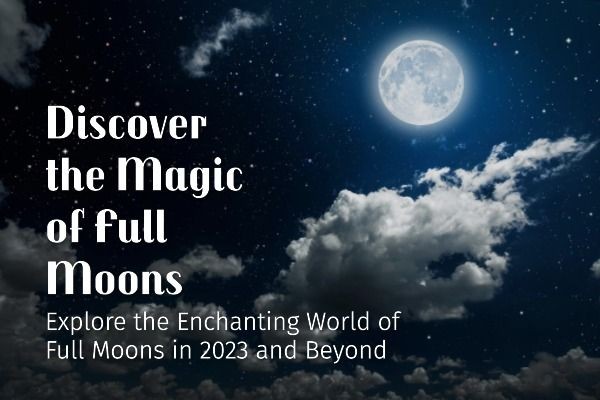Exploring the Enchanting World of Full Moons in 2023 and Beyond
The Full Moon has captivated human hearts and minds for millennia, inspiring myths, traditions, and agricultural activities across diverse cultures. In this blog post, we will delve into the intriguing world of Full Moons, exploring the types, traditional names, and the science behind these celestial wonders. From the upcoming Full Moon in 2023 to the names associated with each, we'll unlock the mysteries of this enthralling lunar phase.
Full Moon in October 2023: The next Full Moon in 2023 will grace our skies at 4:24 p.m. Eastern on October 28. This Full Moon will have a special celestial companion, the bright planet Jupiter, visible to the lower left of the Moon. Moreover, a partial lunar eclipse will be visible from various parts of the world, including Africa, Europe, Asia, and Australia. The Moon will appear full for about three days centered around this time, creating a captivating Full Moon weekend.
The Science of Full Moons: A Full Moon occurs when the Earth is precisely aligned between the Sun and the Moon. This alignment ensures that the entire side of the Moon facing Earth is brilliantly illuminated by sunlight. The Moon's orbit around Earth causes variations in the angle of sunlight, leading to the different lunar phases we observe. A complete cycle from one Full Moon to the next, known as the synodic month, lasts approximately 29.5 days.
The Different Names for Full Moons: Full Moons come with a rich tapestry of names, often rooted in cultural, agricultural, and natural observations. For example, Native American, Colonial American, and other North American traditions have contributed names to Full Moons based on seasonal shifts and natural events. Here's a glimpse of some of these names:
- Wolf Moon (January): Named for the cries of hungry wolves.
- Snow Moon (February): A nod to the heavy snowfall of the month.
- Worm Moon (March): Named after earthworms, signaling thawing grounds.
- Pink Moon (April): In honor of blossoming pink wildflowers.
- Flower Moon (May): Celebrating the bloom of flowers.
- Strawberry Moon (June): Marks the prime strawberry harvest season.
- Buck Moon (July): Recognizing the new antlers on bucks.
- Sturgeon Moon (August): Named after the abundant sturgeon fish.
- Corn Moon (September): Signifying the corn harvesting period.
- Hunter's Moon (October): Commemorating the hunting season preceding winter.
- Beaver Moon (November): Reflects the time when beavers are busy building their winter dams.
- Cold Moon (December): Evocative of winter's chill.
Special Full Moon Events: There are a few additional names for Full Moons that commonly find their way into public conversations and news:
- Super Moon: Reserved for a Full Moon that aligns with the lunar perigee, making it unusually large and luminous.
- Blue Moon: The second Full Moon in a month with two Full Moons.
- Harvest Moon: Rising close to the autumnal equinox, often displaying an orange tint, and historically aiding farmers in gathering their produce.
Common Questions About Full Moons: We'll address some common questions about Full Moons, such as the difference between Full Moons and New Moons, how Full Moons influence tides, and whether Full Moons have an impact on human behavior.
Full Moons, with their diverse names and cultural significance, continue to capture our imagination and connect us to the cosmos. Whether you're a passionate stargazer or an occasional night sky admirer, Full Moons invite introspection and marvel. As we look ahead to Full Moons in 2024, let's remember the enchanting allure of these celestial events.








